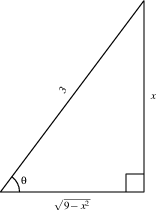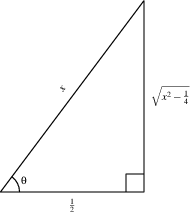
Home
The Fundamental Theorem of Calculus
Three Different ConceptsThe Fundamental Theorem of Calculus (Part 2)
The Fundamental Theorem of Calculus (Part 1)
More FTC 1
The Indefinite Integral and the Net Change
Indefinite Integrals and Anti-derivativesA Table of Common Anti-derivatives
The Net Change Theorem
The NCT and Public Policy
Substitution
Substitution for Indefinite IntegralsExamples to Try
Revised Table of Integrals
Substitution for Definite Integrals
Examples
Area Between Curves
Computation Using IntegrationTo Compute a Bulk Quantity
The Area Between Two Curves
Horizontal Slicing
Summary
Volumes
Slicing and Dicing SolidsSolids of Revolution 1: Disks
Solids of Revolution 2: Washers
More Practice
Integration by Parts
Integration by PartsExamples
Integration by Parts with a definite integral
Going in Circles
Tricks of the Trade
Integrals of Trig Functions
Antiderivatives of Basic Trigonometric FunctionsProduct of Sines and Cosines (mixed even and odd powers or only odd powers)
Product of Sines and Cosines (only even powers)
Product of Secants and Tangents
Other Cases
Trig Substitutions
How Trig Substitution WorksSummary of trig substitution options
Examples
Completing the Square
Partial Fractions
IntroductionLinear Factors
Irreducible Quadratic Factors
Improper Rational Functions and Long Division
Summary
Strategies of Integration
SubstitutionIntegration by Parts
Trig Integrals
Trig Substitutions
Partial Fractions
Improper Integrals
Type 1 - Improper Integrals with Infinite Intervals of IntegrationType 2 - Improper Integrals with Discontinuous Integrands
Comparison Tests for Convergence
Differential Equations
IntroductionSeparable Equations
Mixing and Dilution
Models of Growth
Exponential Growth and DecayLogistic Growth
Infinite Sequences
Approximate Versus Exact AnswersExamples of Infinite Sequences
Limit Laws for Sequences
Theorems for and Examples of Computing Limits of Sequences
Monotonic Covergence
Infinite Series
IntroductionGeometric Series
Limit Laws for Series
Test for Divergence and Other Theorems
Telescoping Sums and the FTC
Integral Test
Road MapThe Integral Test
Estimates of Value of the Series
Comparison Tests
The Basic Comparison TestThe Limit Comparison Test
Convergence of Series with Negative Terms
Introduction, Alternating Series,and the AS TestAbsolute Convergence
Rearrangements
The Ratio and Root Tests
The Ratio TestThe Root Test
Examples
Strategies for testing Series
Strategy to Test Series and a Review of TestsExamples, Part 1
Examples, Part 2
Power Series
Radius and Interval of ConvergenceFinding the Interval of Convergence
Power Series Centered at $x=a$
Representing Functions as Power Series
Functions as Power SeriesDerivatives and Integrals of Power Series
Applications and Examples
Taylor and Maclaurin Series
The Formula for Taylor SeriesTaylor Series for Common Functions
Adding, Multiplying, and Dividing Power Series
Miscellaneous Useful Facts
Applications of Taylor Polynomials
Taylor PolynomialsWhen Functions Are Equal to Their Taylor Series
When a Function Does Not Equal Its Taylor Series
Other Uses of Taylor Polynomials
Partial Derivatives
Visualizing Functions in 3 DimensionsDefinitions and Examples
An Example from DNA
Geometry of Partial Derivatives
Higher Order Derivatives
Differentials and Taylor Expansions
Multiple Integrals
BackgroundWhat is a Double Integral?
Volumes as Double Integrals
Iterated Integrals over Rectangles
How To Compute Iterated IntegralsExamples of Iterated Integrals
Cavalieri's Principle
Fubini's Theorem
Summary and an Important Example
Double Integrals over General Regions
Type I and Type II regionsExamples 1-4
Examples 5-7
Order of Integration
Examples
In this video, we work three examples, one with $x=a
\tan(\theta)$, one with $x = a\sin(\theta)$, and one with $x = a
\sec(\theta)$. Worked out solutions are written below the
video.
Examples from the video.
DO: After watching the video, write down and work these examples on your own, slowly, thinking of the whys and hows of each step.
Example 1: $\int \bigl(4+x^2\bigr)^{-3/2}\, dx$DO: Work through before looking ahead.
Solution 1: $\displaystyle\int
\bigl(4+x^2\bigr)^{-3/2}\, dx \overset{\fbox{$ \,\,
x\,=\,2\tan\theta\\dx\,=\,2\sec^2\theta\,d\theta$}}{=}\int \bigl(4
+ 4\tan^2\theta\bigr)^{-3/2} 2 \sec^2\theta \,d\theta=\int \bigl(4
\sec^2\theta\bigr)^{-3/2} 2 \sec^2(\theta) \,d\theta$
$\displaystyle =4^{-3/2}\cdot 2\int\sec^{-3}\theta\sec^2\theta\,d\theta=\frac{2}{8}\int\sec^{-1}\,d\theta=\frac{1}{4}\int \frac{d\theta}{\sec\theta} = \frac{1}{4}\int \cos\theta\, d\theta = \frac{1}{4}\sin\theta+C.$
$\displaystyle =4^{-3/2}\cdot 2\int\sec^{-3}\theta\sec^2\theta\,d\theta=\frac{2}{8}\int\sec^{-1}\,d\theta=\frac{1}{4}\int \frac{d\theta}{\sec\theta} = \frac{1}{4}\int \cos\theta\, d\theta = \frac{1}{4}\sin\theta+C.$
| Consider our answer above. In order to convert back into terms of $x$, we must figure out what $\sin(\theta)$ is in terms of $x$. By rewriting our original substitution we see that $\tfrac x 2=\tan\theta$. Use this to draw a right triangle, with opposite side $x$ and adjacent side $a=2$. The hypotenuse is then $\sqrt{a^2+x^2}=\sqrt{4+x^2}$. We need to find $\sin\theta$ in terms of $x$, and we see from the triangle that $\sin\theta=\frac{x}{\sqrt{x^2+4}}$. |
 |
---------------------------------------------------------------------------
Example 2: $\int \sqrt{9-x^2}\, dx$
DO: Work through before looking ahead.
Solution 2: $\displaystyle\int \sqrt{9-x^2}\, dx\overset{ \fbox{$ \,\,x\,=\,3 \sin\theta\\dx\,=\,3\cos\theta\,d\theta$} }{=} \int \left(\sqrt{9-9\sin^2\theta}\right)3\cos\theta\,d\theta=3\cdot 3\int\sqrt{\cos^2\theta}\cos\theta \,d\theta=9\int\cos^2\theta \,d\theta$
$\displaystyle\quad =9\int\frac{1+\cos(2\theta)}{2}\,d\theta=\frac{9}{2}\int(1+\cos(2\theta))\,d\theta =\frac{9}{2} \left(\theta+\frac{\sin(2\theta)}{2}\right)+C=\frac{9}{2}\bigl(\theta+\sin\theta\cos\theta\bigr)+C $$
| Here we have used the methods of the last
learning module to evaluate the trig integral, including the handy trig identities for
$\cos^2\theta$ and $\sin(2\theta)$. (You need to
know these by heart). We look at the
terms in our final answer above. We use the triangle
to convert $\sin\theta\cos\theta$ back into terms of
$x$. Finally, we must write $\theta$ in terms of
$x$. We use our original substitution:
$\frac{x}{3}=\sin x$ gives us $\sin^{-1}(\tfrac x
3)=\theta$. |
 |
---------------------------------------------------------------------------
Example 3: $\displaystyle\int \frac{dx}{\sqrt{4x^2-1}}$
DO: Work through before looking ahead.
Solution 3: $\displaystyle\int \frac{dx}{\sqrt{4x^2-1}} \overset{ \fbox{$ 2x\,=\, \sec\theta\\2dx\,=\,\sec\theta\tan\theta\,d\theta$} }{=} \int \frac{\frac{1}{2}\sec\theta\tan\theta\,d\theta}{\sqrt{\sec^2\theta-1}}
\overset{ \fbox{$ \sec^2\theta-1\,=\,\tan^2\theta$} }{=} \frac{1}{2}\int \frac{\sec\theta\tan\theta\,d\theta}{\sqrt{\tan^2\theta}}$
$\displaystyle= \frac{1}{2}\int \frac{\sec\theta\tan\theta\,d\theta}{\tan\theta}=\frac{1}{2}\int\sec\theta\,d\theta=\frac{1}{2} \ln\bigl\lvert\sec\theta+\tan\theta\bigr\rvert +C. $
| We now convert to terms of $x$:
$\sec\theta=2x$, so $\cos\theta=\frac{1}{2x}$. The
triangle could therefore have adjacent side of 1, and
hypotenuse of $2x$, and the opposite side
$\sqrt{4x^2-1}$. We can also have adjacent of
$\frac{1}{2}$ and hypotenuse of $x$. (Why?) This gives the
opposite side the value of $\sqrt{x^2-\frac{1}{4}}$, as in
the diagram. Either way is fine. Looking at our
values above, we only need deal with $\tan \theta$, since we
know $\sec\theta=2x$. From the triangle,
$\tan\theta=\frac{\sqrt{x^2-1/4}}{1/2}$. If we had
used the other triangle, we would get
$\tan\theta=\frac{\sqrt{4x^2-1}}{1}$ -- are these the same values? |
 |
So $\displaystyle\int \frac{dx}{\sqrt{4x^2-1}} =\frac{1}{2} \ln \bigl\lvert \,2x + \sqrt{4x^2-1}\,\bigr\rvert + C.$